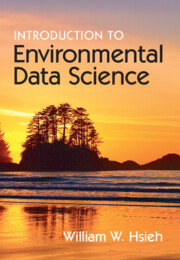Book contents
- Frontmatter
- Contents
- Preface
- Notation Used
- Abbreviations
- 1 Introduction
- 2 Basics
- 3 Probability Distributions
- 4 Statistical Inference
- 5 Linear Regression
- 6 Neural Networks
- 7 Non-linear Optimization
- 8 Learning and Generalization
- 9 Principal Components and Canonical Correlation
- 10 Unsupervised Learning
- 11 Time Series
- 12 Classification
- 13 Kernel Methods
- 14 Decision Trees, Random Forests and Boosting
- 15 Deep Learning
- 16 Forecast Verification and Post-processing
- 17 Merging of Machine Learning and Physics
- Appendices
- References
- Index
15 - Deep Learning
Published online by Cambridge University Press: 23 March 2023
- Frontmatter
- Contents
- Preface
- Notation Used
- Abbreviations
- 1 Introduction
- 2 Basics
- 3 Probability Distributions
- 4 Statistical Inference
- 5 Linear Regression
- 6 Neural Networks
- 7 Non-linear Optimization
- 8 Learning and Generalization
- 9 Principal Components and Canonical Correlation
- 10 Unsupervised Learning
- 11 Time Series
- 12 Classification
- 13 Kernel Methods
- 14 Decision Trees, Random Forests and Boosting
- 15 Deep Learning
- 16 Forecast Verification and Post-processing
- 17 Merging of Machine Learning and Physics
- Appendices
- References
- Index
Summary
NN models with more hidden layers than the traditional NN are referred to as deep neural network (DNN) or deep learning (DL) models, which are now widely used in environmental science. For image data, the convolutional neural network (CNN) has been developed, where in convolutional layers, a neuron is only connected to a small patch of neurons in the preceding layer, thereby greatly reducing the number of model weights. Popular architectures of DNN include the encoder-decoder and U-net models. For time series modelling, the long short-term memory (LSTM) network and temporal convolutional network have been developed. Generative adversarial network (GAN) produces highly realistic fake data.
Keywords
- Type
- Chapter
- Information
- Introduction to Environmental Data Science , pp. 494 - 517Publisher: Cambridge University PressPrint publication year: 2023
- 2
- Cited by

